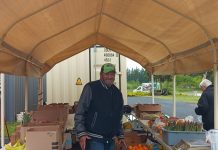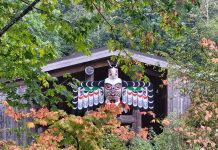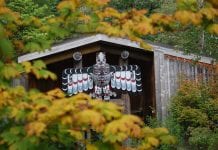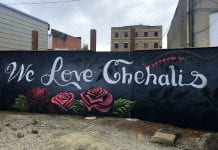That classic American poem, Spoon River Anthology, describes the dead in the village cemetery rising in front of their headstones and telling their stories. Lovers united or unrequited, fortunes lost, soaring victories, searing defeats and other stories, weave together to become the fabric of Spoon River’s history.
While the mountain villages of Packwood, Randle and Glenoma may not have the dead rising in the cemeteries to tell tales, the epitaphs on the headstones in the village cemeteries memorialize rich lives from the earliest days. Some describe unusual events, like the death of William Jobe, first to be buried at Randle’s Silver Creek Cemetery in 1894. He was fatally gored by a bull at the Cora Crossing of the Cowlitz River, likely as he attempted to coax the recalcitrant animal across.

Dave and Martha Garoutte know these stories especially well. Not only are they commissioners in Lewis County Cemetery District #4 , they’re also curators at Packwood’s White Pass Country Historical Museum. They’ve assembled the essential history of the Packwood, Randle and Glenoma cemeteries.
I met Dave when I bought plots in Packwood’s cemetery and later met Martha at the museum. When I caught up with them, Martha had just wrapped up a meeting in one of the museum’s elegant old school rooms. It was once Packwood Elementary. She and I talked while waiting for Dave to return from High Rock Lookout. He’d taken a Port-a-Potty there for the lookout restoration crew.
“I take care of the money and the deeds and things like that,” she explained. “Dave’s the history buff.” As it turns out, today is their anniversary and they’re going out to Josie’s to celebrate. I’m grateful they’re taking the time to chat with me on their special day.

She gave me a copy of the history they wrote. It describes the cemeteries during their founding days, as far back as 1894. You can read the document yourself when you to stop by the museum.
Dave returned looking somewhat rumpled, naturally, since he’d been over 30 miles of potholed forest service roads on the return from High Rock Lookout.
After he cleaned up a bit, we sat together in one of museum’s old school rooms.
“You know we have a Civil War veteran buried in Rainey Valley,” he said. “And a Canadian RAF flyer too.”
What possessed him to take on the Cemetery Commissioner’s role?
“I’m really interested in history so I was helping Hoy Baker then, who was cemetery commissioner. He retired and asked me to take over and I didn’t have the heart to tell him no.”

“For a while, people in Packwood wouldn’t be buried in the cemetery, it was so overgrown,” Dave said. “We replaced a lot of temporary markers with permanent ones. Some graves had no markers. You have to probe to find them. People just bury the folks and take the money, never put in a marker.”
Dave talked about cemetery plots as real estate. The certificate deed gives you the right to be buried in the plot, but doesn’t give you the land. Cemetery plots come good, better and best. A single cremation plot can hold up to four cremations – quite economical. Flat headstone plots rank better. They’re most available and maintenance easily mows over top of them. Upright headstone plots, no longer sold, rank best. They are most visible and maintenance has to mow around them.

Officially, Dave is commissioner for Packwood Evergreen. Two other commissioners oversee Silver Creek and Rainey Valley. Peggy Hirte-Uhlorn, who serves Rainey Valley, said, “When I volunteered, I knew I was working with a good group of people. My dad is buried in another state and somebody is the caretaker there. I’m happy to do it.”
Silver Creek and Rainey Valley nestle like small meadows at the feet of mountains rising from the Cowlitz River. One remarks at their beauty. Silver Creek exudes peace off the beaten path near milepost three on Silverbrook Road. The mountains start climbing right behind it. Rainey Valley straddles US 12 in several sections near the Stiltner Creek crossing. Flowers and flags on the neatly mowed lawns decorate the roadside.
At Silver Creek, I discovered the headstone of the founding family of the town of Randle – the Randles. There were many more names one recognizes from geographical places, like Purcell of Purcell Peak. An elegant white marble headstone memorializes a man who died in a fire at Traveler’s Inn in Randle in 1916.

At Rainey Valley, more names associated with places appear: Stiltner of Stiltner Creek, Riffe of the town of Riffe, now flooded by Riffe Lake. Family names occur in combination on headstones, revealing the fabric of relationships from pioneer days.
After visiting Silver Creek and Rainey Valley, I drove to Packwood Evergreen on Cannon Road in the High Valley community. Precipitous Butter Butte, last peak in the Tatoosh Range, eternally watches over the quiet memorials there. Dave and Martha stood by their car on the drive, dressed for their night out. I felt a little guilty but thankful they agreed to help me out on their anniversary day.
Dave showed me where relatives of Billy Packwood, the Barnetts, are buried. Their primitive original headstones are greatly faded. One is no more than a block of poured cement, the epitaph appearing to have been written with a fingertip. The cemetery district has placed newer markers below these that capture the illegible text.
Of course, I visited the plots I owned and considered my end. But anniversaries are happier than funerals and I left Dave and Martha to theirs. Visit the museum sometime, say hello to Dave and Martha, and go see the rescued history in the Lewis County mountain cemeteries. There are great stories hidden there.













































